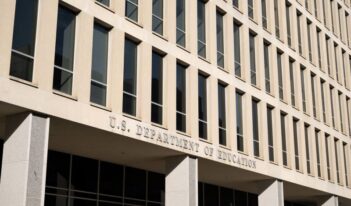
A recent lawsuit highlights tensions between two federal agencies overseeing the management of student loans.
Americans may soon see a drastic change in how their student loans are serviced.
Student Debt Crisis (SDC), a nonprofit focused on advocacy and educational programming for student borrowers, recently filed a lawsuit in federal court against the Consumer Financial Protection Bureau (CFPB) and the U.S. Department of Education arguing that these agencies have “exacerbated” a student loan crisis, ensnaring valuable initiatives such as the popular Public Service Loan Forgiveness Program (PSLF).
To address the nation’s growing student debt, Congress in 2007 created PSLF, which offers federal student loan forgiveness to borrowers who make payments over 10 years of public service. Several private loan servicers manage the Education Department’s $1 trillion-plus federal student loan portfolio, which includes PSLF applicants. The largest of these servicers, the Pennsylvania Higher Education Assistance Agency (PHEAA), operates under the name FedLoan Servicing. The Education Department made FedLoan the primary servicer for borrowers working toward PSLF, so PHEAA, a private company, made over $201 million from its servicing of Department loans for the fiscal year ending in June 2019.
Yet the CFPB received over 3,000 PHEAA-related complaints between September 2017 and August 2019 due to its handling of student loans.
Some borrowers reported having trouble convincing their servicers to correct inaccurate records of their qualified payment histories, while others said call centers gave misleading advice in choosing PSLF-compliant repayment plans. In response, Congress authorized a $700 million temporary PSLF expansion (TEPSLF) for borrowers who had made good faith attempts to meet PSLF requirements.
Congress’s expansion of funding brought still more problems. It turns out that the Education Department wanted TEPSLF applicants first to apply for, and be denied, PSLF relief. In effect, borrowers needed to apply for a program they knew they did not qualify for, a confusing requirement that has been shown to be responsible for 71% of TEPSLF denials.
By June 2019, fewer than 1 percent of PSLF applicants had their loans forgiven, and only 4 percent of TEPSLF applicants had any success in reconfiguring their loans. By September, the Education Department had reportedly spent only around $27 million of the $700 million allocated by Congress. According to SDC, these figures demonstrate severe mismanagement of federal student loans.
SDC alleges that the Education Department turned a blind eye to borrower complaints. The nonprofit group argues that its claims are supported by findings from the U.S. Department of the Treasury, the U.S. Government Accountability Office, and even the Education Department’s Office of Inspector General. The Inspector General concluded in March of last year that the Department “rarely holds servicers accountable” for loan mismanagement. In addition, SDC claims that Congress authorized the CFPB to oversee federal student loan services like PSLF, and that the CFPB’s refusal to do so violates the Administrative Procedure Act (APA).
The Dodd-Frank Wall Street Reform and Consumer Protection Act, legislation adopted in the wake of the 2008 financial crisis, created the CFPB and granted the agency supervisory authority over “larger participants” in the market for certain consumer financial services. In 2013, the CFPB issued a student loan servicing supervision rule that specified its supervisory powers over large student loan servicers, which SDC argues includes entities like PHEAA because its federally held loans are made pursuant to Title IV of the Higher Education Act of 1965. Together, Dodd-Frank and the CFPB’s 2013 rule establish a non-discretionary mandate to regulate public student loans, claims SDC.
In 2018, former CFPB Director Mick Mulvaney announced a new supervision rule stating that the CFPB has supervisory authority over student loans owned by private creditors but not over federally held student loans, a notable policy shift from the Obama Administration.
The 2018 rule is a “material deviation” from the CFPB’s older rule, SDC argues. As a result, SDC claims that CFPB should have undertaken a full notice-and-comment period during which time stakeholders could have voiced concerns about the policy change. SDC further alleges that the CFPB failed to identify the major policy issues prompting the change, stating that the 2018 rule “lacks any explanation of its basis and purpose” and thus violates the APA’s “arbitrary and capricious” clause.
SDC argues that the federal government has even further problems related to oversight of loan servicers. Pursuant to the Dodd-Frank Act, two memoranda of understanding (MOUs) established supervisory and oversight cooperation between the CFPB and the Education Department. The MOUs stated that private education loan complaints initially would be directed to the CFPB, while federal loan complaints would go to the Department. The agencies could then exchange nonpublic information to resolve complaints, an exchange on which the CFPB relied to monitor programs like PSLF, states SDC.
But the Education Department unilaterally rescinded the MOUs in 2017, citing the CFPB’s purportedly improper Obama-era expansion of its oversight power by failing to direct complaints for federally held loans to the Department. Current CFPB Director Kathleen Kraninger initially blamed the lack of a replacement MOU on the absence of a director of the agency’s student loan office in charge of coordinating with the Education Department. But former PHEAA executive Robert Cameron has since filled that office, and yet no new MOU has been adopted. The CFPB recognizes that the Dodd-Frank Act requires an information-sharing MOU, and suggests that the Education Department is now blocking that effort.
As a result, SDC asks the court to vacate the 2018 rule, restore the CFPB’s supervisory authority over federally held student loans, and require a Dodd-Frank-compliant MOU between the CFPB and the Education Department.
The court will have to weigh complex issues of agency independence and evaluate the legitimacy of the CFPB’s Obama-era “handshake agreement” granting it primary oversight of public loan servicers. The Department’s steadfast refusal to cooperate with the CFPB on matters not directly related to large loan servicers of federally held funds, in light of the CFPB’s general agreement that it cannot supervise those servicers, adds a layer of complexity to the case.
Dueling narratives about statutory authority will animate potential oral arguments. Can an agency’s ambiguous supervisory power be taken—or interpreted—away? If so, who has the authority to do so: the courts or Congress?
If this case progresses, its outcome could be monumental for students and regulators alike.



